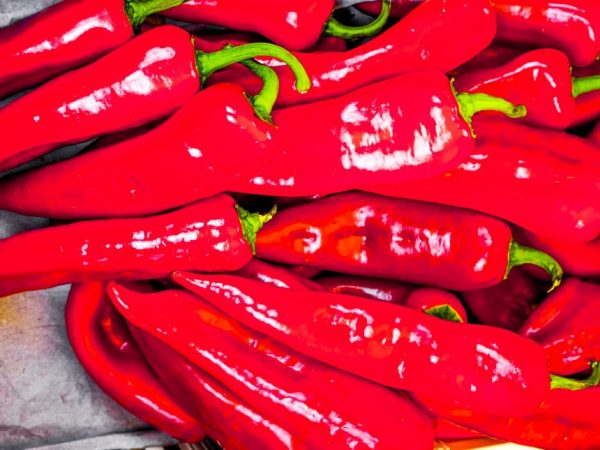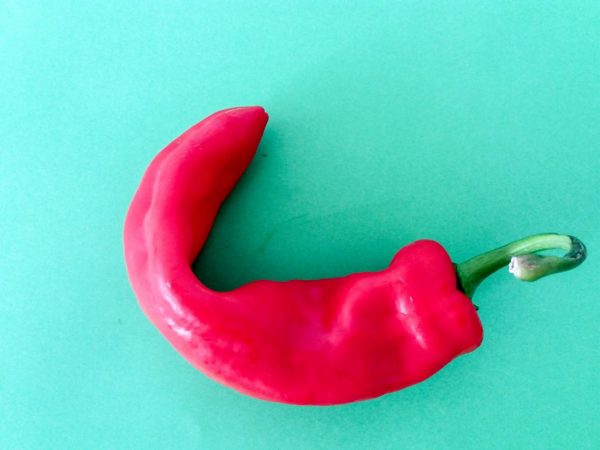Description of Ramiro pepper
Ramiro pepper is considered one of the most popular varieties. It is characterized by a pleasant sweet taste and high yield rates. By the appearance of the pepper, you might think that it is spicy, but this variety belongs to sweet vegetables.

Pepper Ramiro
Variety characteristic
Ramiro sweet pepper was developed by Italian breeders.
This sweet variety of bell pepper is included in the State Register of the Russian Federation. According to its characteristics, it is suitable for cultivation in all regions of the country. It can be planted not only in a greenhouse, but also in open areas.
The growing season of the variety is only 120 days, and with proper care, the fruit ripens 100 days after planting the seeds.
Description of the bush
Description of the bush: the pepper has a developed and powerful bush that can reach a height of 100 cm.
The leaves are large and covered with a few fine wrinkles. The color of the leaves is dark green. At least 10 fruits can form on one bush. The root system and the main stem are well developed, so it is not necessary to carry out a garter, even with a large number of large fruits, the bush will not break off.
Description of the fetus
The fruit has the following characteristics:
- The color palette of the fruits is varied: red, yellow and green bell peppers of this series are often found.
- the shape is elongated, the tip is slightly rounded;
- the length of an individual fruit can reach 30 cm;
- the average wall thickness is 0.7 cm;
- the weight is in the range of 100-150 g.
The taste is pleasant. Ramiro peppers are much sweeter than most other bell peppers. This sweet vegetable contains B vitamins. Sweet pepper contains a high concentration of beneficial trace elements that have a positive effect on the human digestive system. Suitable for universal use. Delicious salads are made from it, suitable for preservation. Many people use it fresh.
Planting seeds
If you do not have a greenhouse, then the seeds should be planted in mid-February and stored in a warm room. For better germination, seeds should be pre-treated with a manganese solution to disinfect them from bacteria. After that, only those seeds that have swollen are selected. The seeds that have floated to the surface must be thrown away, because they are not suitable for germination. After processing, the seeds must be placed on a fabric surface and dried on a battery.
Light, loose soil with a low acid content should be used for planting seeds. The alkali level should not exceed 4%. The ideal soil can be purchased at the store or created at home. To prepare fertile soil, you need to mix garden soil, humus and sand, in a ratio of 1: 2: 1. To increase the looseness of the soil, it is recommended to add 1 glass of wood ash to the mixture. The seeds are planted to a depth of 1.5 cm for better root development.
Growing seedlings

Not worth pouring
The containers should be covered with plastic wrap to create a greenhouse environment. You also need to monitor the correct temperature regime. For the best germination of sweet pepper seeds, a temperature of about 25 ° C is needed. At night, the temperature should be in the range of 15-18 ° C. This is necessary in order to prepare the seedlings for the daily regimen after transplanting to a permanent place.
Seedlings should be watered once every 4 days. Abundant watering is not recommended, because this can lead to decay of the root system. As a result, seedlings will decrease in quantity. Watering should be carried out with warm water, because it is better absorbed by the plant. The film should be removed from the container every 2 days to allow air to enter.
Open ground transplant
Ideal neighbors for this sweet pepper are cucumbers, cabbage, or zucchini. You should not plant potatoes or tomatoes next to peppers, because after these crops the soil is rather poor in useful elements. Transplanting seedlings into open ground should be carried out in early May, when the soil has already warmed up to a temperature of 15-18 ° C.
Before planting, the ground must be watered with warm water and treated with a solution of copper sulfate. This will destroy all bacteria that have been stored in the soil. A distance of 80 cm should be adhered to between rows, and 60 cm between holes. The planting depth is 3 cm. After planting, the beds must be watered and tamped again.
Care
First of all, you need to remember about mulching, which is carried out using straw and humus. Mulch will protect plants from excess weeds and keep the soil from drying out. Crops with tall bushes should be planted nearby to protect the pepper plant from drafts and wind.
Top dressing
Pepper Ramiro needs proper feeding. The main feature of this pepper is that there is no need to buy fertilizers. You can use existing plants and organics. At the moment when flowering begins, feeding is carried out using nettle, dandelion or woodlice tops. The tops should be mixed with a small amount of mullein and peat, and then add 3 tablespoons under each bush. The second feeding is carried out at the time of fruiting. Prepare a solution of bird droppings and water, and pour 1 liter into each bush.
Watering and shaping a bush
Watering the plant should be carried out with water of a certain temperature. It is best to use water at 28 ° C. Before flowering, watering is carried out once a week. If there is hot weather outside for a long time, then you need to water the plants 1 time in 3 days. After flowering, watering is carried out every 2 days. For 1 m2, 10 liters of warm water should be used.
You also need to regularly carry out the formation of the bush. This is necessary for high yields. When the seedling reaches a height of 25 cm, the first flowering begins. It must be removed for the proper development of the bush. The second formation should be carried out after the appearance of the 5th pair of leaves. It is necessary to leave only 3 shoots and remove all weak ovaries. This is done in order to increase the size of the formed fruit.
Diseases and parasites
The description indicates that Ramiro pepper is not susceptible to disease. But watering the plants abundantly can lead to the development of fungal infections. You can get rid of fungal diseases with the help of the Barrier drug. It can also be used as a preventive substance, because it contains those substances that can improve the immune system of the plant.
If diseases such as late blight or anthracnose occur, medicinal preparations should be used. The ideal option would be Oxyhom or Bordeaux liquid solution. Spraying with these preparations is carried out one month before harvesting.
Bell peppers can be affected by parasites. Its main enemies are spider mites, aphids or slugs.In the fight against these pests, drugs are used called Regent or Zaslon. You can also use self-prepared solutions from available tools. The ideal solution would be a solution of garlic, onion or tobacco dust.
Conclusion
Gardeners speak about sweet pepper Ramiro only on the positive side, because this product has a pleasant taste, colorful colors and high yield rates. If you follow all the care measures, then growing will be a pleasure for you, and you can also collect really high quality products.


